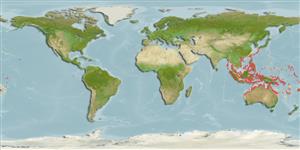Common names from other countries
>
Eupercaria/misc (Various families in series Eupercaria) >
Labridae (Wrasses) > Corinae
Etymology: Halichoeres: Greek, als, alis = salt + Greek, choiros = pig (Ref. 45335).
More on author: Bleeker.
Environment: milieu / climate zone / depth range / distribution range
Ecologia
marinhas associadas(os) a recifes; intervalo de profundidade 1 - 15 m (Ref. 9710). Tropical; 32°N - 30°S, 91°E - 170°W
Indo-Pacific: from Bali, Indonesia and Western Australia to Micronesia and Samoa; north to Japan; south to Australia.
Tamanho / Peso / Idade
Maturity: Lm ? range ? - ? cm
Max length : 14.0 cm TL macho/indeterminado; (Ref. 129178)
Espinhos dorsais (total): 9; Raios dorsais moles (total): 11-12; Espinhos anais 3; Raios anais moles: 11 - 12; Vértebras: 25. Stripes on male body blue-green and orangish in life, becoming salmon pink and green anteriorly; a dark spot behind eye contained within a brown band that bifurcates posteriorly. Females with a small black spot on 1st interspinous membrane of dorsal fin, another between 2nd-3rd soft rays; a spot at the upper base of caudal fin. Anterior lateral line scales with 1-4 pores (usually 2). Pelvic fins of males reaching to or beyond the anus.
Found mostly on shallow coral reefs and rocky shores (Ref. 9823). Found solitary or in small groups on sheltered reefs over 15 m depth (Ref. 90102). Feed on small invertebrates such as polychaetes, copepods, isopods and forams (Ref. 1602).
Life cycle and mating behavior
Maturidade | Reprodução | Desova | Ovos | Fecundidade | Larvas
Distinct pairing during breeding (Ref. 205).
Randall, J.E., G.R. Allen and R.C. Steene, 1990. Fishes of the Great Barrier Reef and Coral Sea. University of Hawaii Press, Honolulu, Hawaii. 506 p. (Ref. 2334)
Categoria na Lista Vermelha da IUCN (Ref. 130435)
CITES (Ref. 128078)
Not Evaluated
Ameaça para o homem
Harmless
Utilização humana
Aquário: Aquários públicos
Mais informação
ReferênciasAquaculturaPerfil para aquaculturaEstirpesGenéticaElectrophoresesHereditariedadeDoençasProcessamentoMass conversion
Ferramentas
Relatórios especiais
Descarregue XML
Fontes da internet
Estimates based on models
Preferred temperature (Ref.
115969): 25 - 29.3, mean 28.6 (based on 2325 cells).
Phylogenetic diversity index (Ref.
82804): PD
50 = 0.5000 [Uniqueness, from 0.5 = low to 2.0 = high].
Bayesian length-weight: a=0.01288 (0.00791 - 0.02097), b=3.19 (3.05 - 3.33), in cm Total Length, based on LWR estimates for this species & Genus-body shape (Ref.
93245).
Nível Trófico (Ref.
69278): 2.9 ±0.2 se; based on diet studies.
Resiliência (Ref.
120179): Elevada, tempo mínimo de duplicação da população menor que 15 meses (Preliminary K or Fecundity.).
Fishing Vulnerability (Ref.
59153): Low vulnerability (10 of 100).
